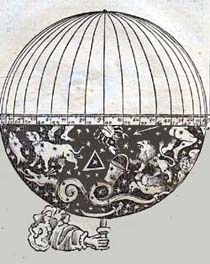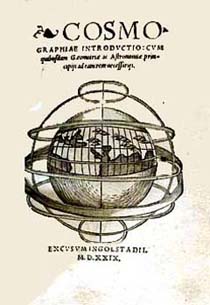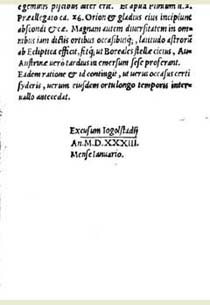|
Many Versions of Cosmographia
As would be expected in a work published over
such a long period of time, there were many different versions
of Cosmographia. Of those published in Latin, there was
the original edition by Apian, the corrected version by Gemma,
the abridgement called Cosmographiae Introductio, and
three other versions enlarged with contributions by Gemma appearing
in 1531, 1539, and 1584. The first of these additions was De
locorum describendorum ratione (Concerning the method of
describing places) with De eorum distantijs inueniendis
(Concerning determining
their distances). In 1539 Usus annuli astronomici
(The use of the astronomical
rings) was added, and in 1584 Astrolabio catholico
(The universal astrolabe). |
|
The Dutch, French and Spanish editions carried
Cosmographia to people beyond the Latin-speaking scholarly
community, enlarging its audience considerably. The Parisian
editions in both Latin and French were printed in italic type
and were "newly illustrated" (not with wholly new cuts,
but with a rearrangement of the illustrations from the previous
editions). The celestial sphere was used on the title pages of
the Parisian editions while the terrestrial
globe was used on the Antwerp editions. |

|
This image of a celestial sphere was used in the Parisian
editions of 1550, 1551, and 1553 on the title page. |
|
|
The 1575 Spanish edition printed at Antwerp
in 1575 was enlarged with excerpts from the writings of Lopez
de Gomara as well as Jerome Girava and a description of cities
and towns in the West Indies was also included. These additions
were also present in the 1581 French and the 1584 Latin editions.
In all, there were 32 editions in Latin, 8
in Dutch, 5 in French and 2 in Spanish. It is surprising that
there was never an English translation of Cosmographia.
Two excerpts from an unpublished translation of the 1524 edition,
the descriptions of Asia and of America, are reproduced in George
Kish's A Source book in geography. |
 
|
The title page, left, of Cosmographiae introductio
shows the date MDXXIX (1529), but the colophon, right, gives
the correct date of 1533. |
|
|
The full title of the abridged version is Cosmographiae
introductio: cum quibusdam Geometriae ac Astronomiae principiis
ad eam rem necessarius (The Introduction to Cosmography with
the necessary principles of Geometry and Astronomy) and its pages
carried the running title "Rudimenta Cosmographia"
(The rudiments of cosmography). Although Apianus' name does not
appear in the Introductio, there is little doubt that
it is his work. The first three editions of this abridgement
(of a total of fourteen) were printed in Ingolstadt, where Apianus
was professor of mathematics, and chapters xxv-xxviii are direct
reprints of the 1524 Cosmographicus liber. Cosmographiae
Introductio was printed only in Latin, and came from presses
in four cities (Ingolstadt, Venice, Cologne, and Paris) over
a period of 23 years. The last edition of Introductio
was published in 1554 from the Venetian press of Fr. Bindoni
. A variant of this edition carries a date on the title page
of 1537 but of 1554 in the colophon at the end of the book. This
also occurred in the first three editions printed at Ingolstadt:
their title pages each show the date MDXXIX (1529), but their
colophons give their actual dates as 1531, 1532, and 1533. |
|
|